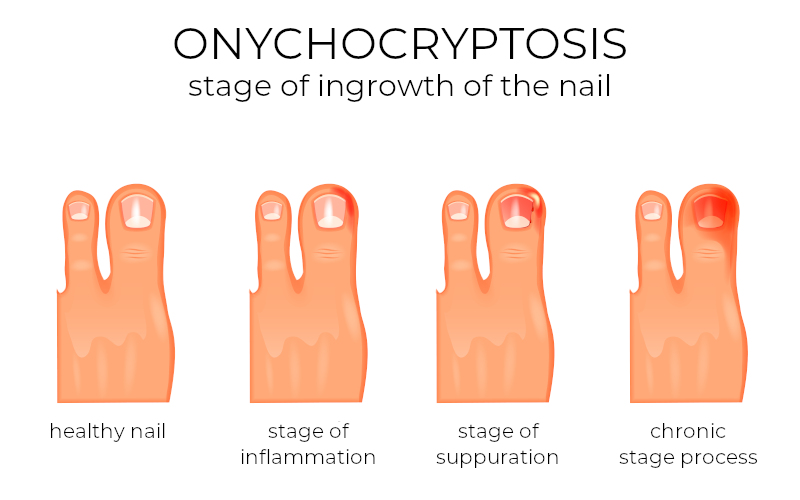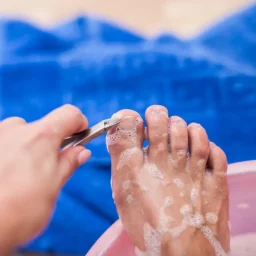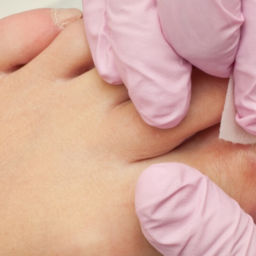
An ingrown toenail, also known as onychocryptosis, is a common condition where the border of a toenail does not grow over the skin but into it. It most commonly affects the big toe but can occur in other toes as well. This condition can cause pain, redness, swelling, and tenderness in the affected area.
Ingrown Toenail Throbbing at Night?
Experiencing big toe or other toenail pain at night can be attributed to several factors, with the most common culprit being an ingrown toenail. An ingrown toenail occurs when the nail grows into the skin surrounding the toe, leading to inflammation and discomfort. This condition is often aggravated by tight fitting shoes being worn. The pressure exerted on the toes aggravates the ingrown nail further.
Moreover, if you regularly cut your toenails too short, the risk of ingrown toenails increases, as the edges of the nails can penetrate the skin. Proper nail care is essential to avoid this issue. Ensure your footwear fits properly and provides ample room for your toes to avoid unnecessary pressure.
If ingrown toenail throbbing at night pain persists, it is advisable to seek medical attention from a foot and ankle specialist. They can alleviate the discomfort, provide appropriate treatment, and offer guidance on preventing future occurrences of ingrown nails, allowing you to sleep peacefully without toe pain disrupting your nights.
What Are The Causes of Ingrown Toenails?
Ingrown toenails, a common and often painful condition, occur when the edges of the toenail grow into the surrounding skin instead of over it. Several factors can contribute to the development of ingrown toenails:
- Improper nail trimming: Cutting toenails too short or rounding the corners can encourage the nail to grow into the skin. It is best to trim nails straight across and avoid cutting them too close to the skin.
- Rigid or Compact shoes: Too tight or narrow shoes worn daily can put too much force on the toes, this exerts a downward motion on the nails. The result is the skin breaks and causes the growth below the epidermal layer resulting in ingrown toenails.
- Trauma or injury: Banging your toe or repetitive trauma in the same toe location can result in an ingrown toenail. The nail may grow abnormally or damage the surrounding tissue.
- Genetics: Some people are more predisposed to developing ingrown toenails due to genetic factors, such as the shape of their toes or the thickness of their nails.
- Fungal infections: Infections like athlete’s foot can distort the nail shape and increase the likelihood of ingrown toenails.
- Poor foot hygiene: Not keeping the feet clean and dry can create an environment conducive to bacterial or fungal infections, potentially leading to ingrown toenails.
- Medical conditions: Certain conditions like diabetes or circulatory problems can affect nail growth and increase the risk of ingrown toenails.

How Can Ingrown Toenails Be Treated?
Treating an ingrown toenail can provide relief and prevent the condition from worsening. Here are some steps to address the problem:
- Properly trim your toenails: Cut your toenails straight across to avoid encouraging the nail to grow into the surrounding skin. Avoid cutting them too short or rounding the corners.
Soak your foot in warm water: Fill a basin with warm water and soak your foot for about 15-20 minutes, three times a day. This will help reduce inflammation and soften the skin around the ingrown toenail. We provide toenail trimming services for our patients who have repeated issues to enure over nail health is not a concern. - Avoid pressure on your toes: Wear well-fitted shoes with enough room for your toes to prevent additional pressure on the affected area.
- Gently raise the nail: After soaking, use a new cotton ball or dental floss to carefully raise the border of the nail that is ingrown away from the skin. This will facilitate growth of the nail above the edges of the skin.
- Apply antibiotic ointment: After lifting the nail, apply an over-the-counter antibiotic ointment to the affected area to prevent infection.
- Protect with a bandage: Place a sterile bandage or gauze over the ingrown toenail to protect it from further irritation and infection.Pain relief: Over-the-counter pain relievers can help manage the pain associated with an ingrown toenail.
If the ingrown toenail throbbing at night pain worsens, becomes infected, or the pain persists, it’s crucial to seek professional medical attention. A healthcare provider can provide appropriate treatment, such as partial nail removal, and offer guidance on how to prevent future ingrown toenails. Don’t hesitate to request an appointment with a podiatrist or foot specialist to address your ingrown toenail effectively.
Visit A Podiatrist At The Right Time! Avoid Unnecessary Pain.
You should consider seeking a podiatrist for an ingrown toenail if you experience persistent pain, swelling, redness, or notice signs of infection, especially if the area around the ingrown toenail feels warm to the touch. These symptoms may indicate that the condition is worsening or has become infected.
Additionally, if you have a history of ingrown toenails or if you are particularly susceptible to developing them due to the shape of your toes or the thickness of your nails, it’s advisable to seek professional help. Podiatrists are specialized in foot and ankle conditions, and they can provide expert assessment and treatment for an ingrown toenail throbbing at night.
A podiatrist can safely and effectively perform procedures like partial nail removal (partial avulsion) or suggest other appropriate treatment for an ingrown toenail that hasn’t responded to home remedies. Early intervention by a podiatrist can prevent complications and promote faster healing, ensuring you receive the best possible care for your ingrown toenail.

